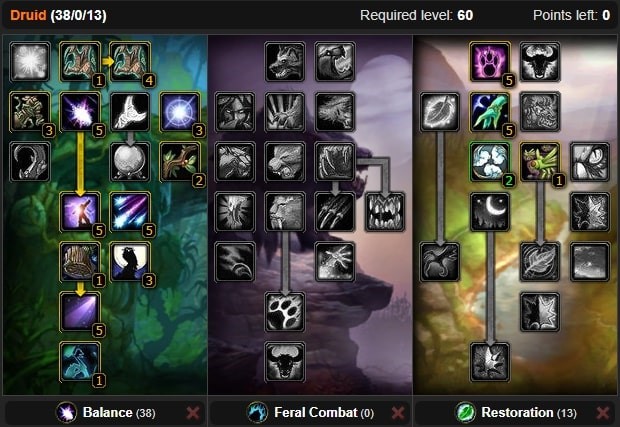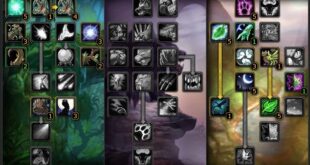Balance Druids represent one of the most challenging yet rewarding specializations in WoW Classic. Often misunderstood and underestimated, Balance offers a unique ranged caster experience that combines powerful burst damage with valuable raid utility. While the specialization faces legitimate challenges in sustained encounters, skilled Balance Druids contribute meaningfully to raid success while enjoying one of the most distinctive playstyles available.
This comprehensive WoW Classic Balance Druid Guide explores everything you need to master Balance Druid gameplay in WoW Classic. We’ll cover optimal talent builds, spell rotations, mana management strategies, gear priorities, and how to maximize your contribution in both PvE and PvP environments. Whether you’re considering Balance for the first time or seeking to refine your existing skills, this guide provides the knowledge necessary to excel.
Understanding Balance Druid Strengths and Weaknesses
Balance Druids occupy a unique position in WoW Classic’s class ecosystem. Understanding both your strengths and limitations helps you maximize your effectiveness while managing realistic expectations about the spec’s capabilities.
Core Strengths
Balance Druids provide exceptional burst damage during short encounter windows. Your ability to quickly eliminate priority targets makes you valuable in dungeon content and PvP situations where extended fights are less common. The combination of Nature and Arcane damage schools gives you flexibility against resistant enemies.
Moonkin Form provides a five percent spell critical strike aura for your entire party, representing significant value for caster-heavy groups. This buff alone justifies bringing a Balance Druid to raids, as the damage increase for other casters often exceeds your personal contribution. Additionally, your ability to Innervate other casters or yourself extends mana pools during crucial encounter phases.
Your hybrid nature allows emergency off-healing and battle resurrection during combat. These utility abilities provide safety nets that pure DPS classes cannot offer, making you valuable beyond simple damage meters.
Core Limitations
Mana efficiency represents the primary challenge facing Balance Druids in WoW Classic. Extended raid encounters deplete your mana pool rapidly, forcing you to downrank spells or stop casting entirely before fights conclude. This limitation significantly impacts your sustained damage output compared to pure DPS classes.
Limited itemization creates gearing challenges, as few items provide optimal stats for Balance gameplay. You’ll often compete with healers for gear or accept suboptimal pieces due to limited alternatives. The situation improves in later content phases but remains problematic throughout Classic.
Your damage output, while respectable during mana availability, falls behind dedicated DPS specs in sustained encounters. Most raid encounters favor sustained damage over burst potential, placing Balance at a disadvantage compared to classes designed purely for damage dealing.
Balance Druid Talent Builds
Selecting the right talent build for your goals maximizes your effectiveness while minimizing the spec’s inherent weaknesses. Different builds suit different content types and playstyles.
Standard Raiding Build
The optimal raiding build invests heavily in the Balance tree while picking up essential utility talents from Restoration. This build prioritizes spell damage, critical strike chance, and mana efficiency to extend your damage window as long as possible.
This build balances damage output with mana sustainability, giving you the longest possible damage window in raid encounters. The Restoration talents enhance your utility while improving mana regeneration through spirit scaling. For detailed PvE strategies using this build, visit our WoW Classic Druid Balance PvE Guide.
Alternative PvP Build
PvP-focused Balance builds adjust talent allocation to emphasize survivability, burst damage, and crowd control capabilities. The reduced fight duration in PvP makes mana efficiency less critical than in raids.
This build allows you to effectively heal in dungeons and PvP while maintaining respectable damage output. The versatility comes at the cost of Moonkin Form and its associated benefits, making this approach less optimal for dedicated Balance players.
Balance Druid Spell Rotation and Priorities
Executing proper spell rotations maximizes your damage output while managing mana consumption. Understanding which spells to cast and when separates competent Balance Druids from exceptional ones.
Standard Single Target Rotation
Your single target rotation balances damage output against mana efficiency. The basic priority system helps you make optimal decisions throughout encounters.
Pre-Pull Setup:
- Apply Mark of the Wild to raid members
- Buff yourself with Thorns
- Ensure full mana before pull
- Position at maximum range
Opening Sequence:
- Cast Faerie Fire if debuff slot available
- Apply Moonfire
- Cast Insect Swarm
- Begin Starfire spam
Sustained Phase:
- Maintain Moonfire and Insect Swarm
- Cast Starfire as your primary damage spell
- Refresh damage over time effects 1-2 seconds before expiration
- Use Innervate on yourself or assigned target when available
Mana Conservation Phase:
- Downrank Starfire to Rank 8 or 9 when mana depletes
- Continue maintaining damage over time effects
- Wand when completely out of mana
- Reserve mana for critical utility if needed
Multi-Target Situations
Balance Druids handle Area of Effect situations differently than single target scenarios. Hurricane provides strong AoE damage but drains mana extremely quickly.
Two to Three Targets:
- Apply Moonfire to all targets if they’ll live long enough
- Cast single target rotation on primary target
- Refresh Moonfires as needed
Four Plus Targets:
- Position for optimal Hurricane coverage
- Cast Hurricane for sustained AoE damage
- Monitor threat levels carefully
- Switch to single target on surviving enemies
Hurricane’s channeling nature leaves you vulnerable to interrupts and damage. Position carefully and be prepared to cancel the channel if you need to move or shift forms for survival.
Cooldown Management
Balance Druids have limited damage cooldowns compared to other casters, making proper usage of available tools crucial.
- Use on yourself during high damage phases
- Coordinate with raid leader for optimal timing
- Consider giving to other casters if your mana is stable
- Save for execute phases if mana allows
Nature’s Swiftness (if talented):
- Instant cast Starfire for burst damage
- Emergency instant Healing Touch for survival
- Execute phase instant cast when optimal
Trinkets:
- Activate spell damage trinkets during hero/lust or high damage phases
- Time trinket usage with Innervate for maximum benefit
- Stack multiple damage modifiers when possible
Mana Management Strategies
Successful Balance gameplay requires exceptional mana management. Your ability to contribute throughout entire encounters depends on conserving mana without sacrificing too much damage output.
Consumable Usage
Proper consumable preparation significantly extends your mana pool and regeneration rates. Investing in consumables demonstrates commitment and improves your performance measurably.
Essential Consumables:
- Major Mana Potions on cooldown during long fights
- Elixir of Greater Intellect for increased mana pool
- Flask of Supreme Power for progression content
- Mageblood Potion for mana regeneration
- Nightfin Soup for additional mana regeneration while casting
Situational Consumables:
- Demonic Runes for emergency mana restoration
- Dark Runes for additional mana when needed
- Superior Wizard Oil for increased spell damage
- Brilliant Wizard Oil for spell damage and mana regeneration
Spell Downranking
Downranking spells reduces mana consumption while maintaining reasonable damage output. Understanding which ranks provide optimal damage per mana helps you extend your effective casting time.
Starfire Downranking:
- Starfire Rank 10 provides maximum damage per cast
- Rank 8-9 offer better damage per mana when conserving
- Use maximum rank until mana forces downranking
- Avoid excessively low ranks that waste global cooldowns
Moonfire and Insect Swarm:
- Always use maximum rank for damage over time spells
- The mana efficiency of DoTs justifies full rank usage
- These spells provide excellent damage per mana regardless
Spirit Regeneration
Spirit provides mana regeneration while not casting, modified by talents like Reflection. Understanding the five-second rule helps you maximize regeneration during encounters.
Five Second Rule Mechanics:
- Mana regeneration stops for five seconds after casting
- Plan brief casting pauses to allow regeneration
- Balance damage loss against mana gained
- More valuable in encounters with natural downtime phases
Strategic pauses during low-priority damage phases can significantly extend your mana pool. Coordinate with raid leaders to identify optimal pause timing based on encounter mechanics.
Stat Priority and Gearing
Understanding which stats benefit Balance Druids most helps you make informed gearing decisions. Limited itemization means accepting suboptimal pieces while prioritizing key stats.
Primary Stat Priority
Spell Hit Rating (up to 16%): Hit rating takes absolute priority until reaching the spell hit cap. Missed spells waste mana and reduce DPS dramatically, making hit rating the most valuable stat until capped. The spell hit cap is 16 percent against raid bosses, requiring 202 hit rating.
Spell Damage: After reaching hit cap, spell damage provides the largest DPS increases. Both Nature and Arcane spell damage benefit Balance equally, though generic spell damage remains most valuable for gear flexibility.
Spell Critical Strike: Critical strikes significantly increase your damage output, especially with talents like Vengeance increasing critical damage. Intellect provides critical strike chance while also increasing your mana pool, making it valuable for both damage and sustainability.
Intellect: Intellect increases your mana pool and provides spell critical strike chance. The larger mana pool extends your damage window before mana conservation becomes necessary, while critical strike chance directly improves damage output.
Spirit: With Reflection talented, spirit provides mana regeneration while following the five-second rule. While less valuable than primary stats, spirit helps sustain longer casting phases and shouldn’t be completely disregarded.
Pre-Raid Best in Slot
Obtaining Pre-Raid BiS gear prepares you for raiding content and demonstrates your commitment to performance. For a complete list of Pre-Raid BiS items for Balance specifically, see our WoW Classic Druid Pre-Raid BiS Guide.
Key Pre-Raid Items:
| Slot | Item | Source |
|---|---|---|
| Head | Crown of the Ogre King | Tribute Run (Dire Maul North) |
| Neck | Drakefire Amulet | Onyxia Attunement Quest |
| Shoulders | Mantle of the Blackwing Cabal | UBRS (General Drakkisath) |
| Back | Cloak of Warding | Crafted (Tailoring) |
| Chest | Robes of the Exalted | Honored with Argent Dawn |
| Wrists | Sublime Wristguards | Stratholme (Magistrate Barthilas) |
| Hands | Hands of Power | Scholomance (Darkmaster Gandling) |
| Waist | Whipvine Cord | Maraudon (Princess Theradras) |
| Legs | Skyshroud Leggings | Stratholme (Nerub’enkan) |
| Feet | Boots of the Full Moon | Stratholme (Magistrate Barthilas) |
| Ring 1 | Songstone of Ironforge | Quest Reward (Alliance) |
| Ring 2 | Don Julio’s Band | Tribute Run (Dire Maul North) |
| Trinket 1 | Briarwood Reed | UBRS (Jed Runewatcher) |
| Trinket 2 | Royal Seal of Eldre’Thalas | Dire Maul (King Gordok) |
| Weapon | Bonecreeper Stylus | Scholomance (Jandice Barov) |
| Off-Hand | Orb of the Forgotten Seer | UBRS Quest Reward |
This gear provides a strong foundation for entering raid content. Some pieces remain competitive even after obtaining raid drops, making the farming investment worthwhile.
Enchanting Priorities
Proper enchants significantly improve your performance. Prioritize high-impact enchants before less valuable ones when managing limited resources.
Essential Enchants:
- Head and Legs: Librams from Zul’Gurub providing spell damage and intellect
- Chest: Greater Stats for overall attribute boost
- Bracers: Mana regeneration or intellect based on preference
- Gloves: Spell damage for direct DPS increase
- Boots: Minor speed for mobility improvement
- Weapon: Spell damage for consistent benefit
- Off-hand: Spell damage where applicable
Balance Druid in Raids
Understanding your role and responsibilities in raids helps you contribute effectively while managing realistic performance expectations. Balance occupies a unique support-DPS position in most raids.
Raid Composition and Buffs
Most raids bring one Balance Druid specifically for Moonkin Aura. This five percent spell critical strike buff for your party represents significant value for caster-heavy groups. Position yourself in parties with Mages, Warlocks, or Shadow Priests to maximize aura benefit.
Your Mark of the Wild provides essential stats for the entire raid. Ensure all raid members maintain this buff throughout encounters. The improved version from talents significantly increases the buff’s value, making it one of your most important contributions.
Innervate represents your most valuable utility ability. Coordinate with raid leaders about Innervate targets, as proper usage can enable extended damage phases for other casters or save healer mana during crucial moments. Self-Innervate when it provides more value than giving it to others, but communicate these decisions.
Encounter Strategies
Adapt your playstyle to specific encounter requirements. Some fights favor your strengths while others highlight your limitations.
Short Encounters: Maximize damage without mana conservation concerns. Use consumables aggressively and maintain maximum rank spells throughout. These encounters showcase Balance’s burst potential without exposing mana weaknesses.
Long Encounters: Begin conserving mana earlier than feels comfortable. Start downranking before completely depleting your mana pool, as maintaining some casting beats going completely out of mana. Reserve enough mana for execute phases where your contribution matters most.
Movement-Heavy Fights: Utilize instant-cast spells like Moonfire and Insect Swarm during movement phases. Your mobility advantage over turret casters like Mages partially compensates for lower overall damage. Maintain damage over time effects during movement to continue contributing.
Multi-Target Encounters: Excel at add management through strong AoE damage. Hurricane provides excellent damage on grouped adds, though mana consumption requires careful management. Balance clearing adds quickly with maintaining enough mana for subsequent phases.
Threat Management
Balance Druids generate significant threat through spell damage. Managing threat carefully prevents deaths and maintains raid stability.
Threat Reduction Strategies:
- Subtlety talent reduces threat generation by 20 percent
- Delay DPS on pull to allow tanks to establish threat
- Monitor threat meters constantly during encounters
- Stop DPS entirely if approaching threat cap
- Use wanding when threat-capped to continue contributing
Dying to threat generates zero DPS and wastes healer mana on your resurrection. Conservative threat management often produces better overall contribution than aggressive DPS that results in death.
Balance Druid in PvP
Balance Druids excel in PvP through burst damage, crowd control, and exceptional survivability. Your hybrid toolkit allows you to adapt to various PvP scenarios effectively.
Battleground Strategies
Your role in battlegrounds varies by map and team composition. Understanding how to contribute optimally in each scenario maximizes your impact.
Warsong Gulch: Support flag carriers through crowd control and healing when needed. Your burst damage helps eliminate enemy flag carriers quickly. Position to intercept enemy offense with roots and Hibernate on druids in animal forms.
Arathi Basin: Defend capture points through superior survivability and crowd control. Your ability to hold points against multiple attackers makes you valuable in defensive roles. Burst down attackers quickly or survive until reinforcements arrive.
Alterac Valley: Contribute through consistent ranged damage in large engagements. Focus priority targets like enemy healers with burst damage combos. Your utility abilities like removing curses and battle resurrection provide value in extended battles.
Burst Damage Combinations
Maximizing burst damage requires properly sequencing abilities for overwhelming pressure on opponents.
Standard Burst Combo:
- Open from range with Moonfire
- Cast Starfire while opponent closes distance
- Root with Entangling Roots
- Apply Insect Swarm
- Cast another Starfire
- Refresh Moonfire if needed
- Re-root when opponent breaks free
This sequence delivers substantial damage while controlling opponent positioning. Skilled execution often forces defensive cooldowns or eliminates targets outright.
Advanced Techniques:
- Use Nature’s Swiftness for instant Starfire burst
- Activate damage trinkets before Starfire casts
- Shift forms to remove movement impairing effects
- Kite opponents with Travel Form between casting windows
Defensive Tactics
Survival defines successful PvP Balance gameplay. Your various defensive tools provide exceptional survivability when used properly.
Form Shifting: Shift to Bear Form when pressured by melee classes. The increased armor and health pool allow you to survive burst damage while your teammates respond. Shift back to cast form during safe windows to continue dealing damage.
Crowd Control Usage: Root melee opponents and create distance with Travel Form. Hibernate enemy druids in animal forms. Cyclone priority targets to remove them from combat temporarily while focusing other enemies.
Mobility Advantages: Your superior mobility allows you to control engagement timing. Escape unfavorable situations through Travel Form and re-engage when circumstances improve. This hit-and-run playstyle frustrates opponents and creates winning opportunities.
Advanced Balance Druid Techniques
Mastering advanced techniques separates good Balance Druids from exceptional ones. These skills require practice but significantly improve your effectiveness.
Optimal Spellcasting
Minimize downtime between casts through proper timing and positioning. Begin casting your next spell immediately after the previous one completes. Position to avoid movement as much as possible, maintaining maximum casting uptime.
Spell Queuing: Queue your next spell slightly before the current cast completes. This technique ensures immediate casting without delays between global cooldowns. Practice the timing to avoid interrupting casts while eliminating gaps between spells.
Emergency Healing
Your hybrid nature allows emergency healing during critical moments. Understanding when to heal versus continuing DPS requires judgment developed through experience.
Healing Decisions:
- Shift and heal when raid members are dying
- Battle resurrect is valuable on progression content
- Personal survival takes priority over minor DPS increases
- Return to DPS quickly after addressing emergency
Practice efficient shifting for emergency heals. Use macros to streamline the process, reducing time spent in forms without contributing.
Resource Tracking
Monitor multiple resources simultaneously for optimal performance. Track your mana percentage, threat level, buff durations, and cooldown availability constantly during encounters.
Add-ons for Tracking:
- Mana bars showing exact percentages
- Threat meters for aggro awareness
- Buff tracking for Omen of Clarity procs
- Cooldown timers for major abilities
Developing strong resource awareness allows you to make optimal decisions about spell selection, cooldown usage, and when to shift forms for utility purposes.
Common Balance Druid Mistakes
Recognizing and avoiding common mistakes improves your performance significantly. Many Balance Druids struggle with similar issues that, once corrected, lead to substantial improvement.
Mana Management Errors
Running completely out of mana early in encounters cripples your contribution. Many Balance Druids delay downranking too long, hoping their mana will somehow last. Start conserving before you feel necessary, as recovering from complete mana depletion is nearly impossible.
Using Innervate too late represents another common error. Innervate provides more value when used with remaining mana to cast with, rather than after complete depletion. Time Innervate to extend your maximum damage phase, not to barely continue casting.
Inefficient Spell Selection
Spamming maximum rank Starfire until completely out of mana wastes resources. Begin downranking earlier to maintain consistent casting throughout encounters. Some damage output throughout the entire fight provides more value than maximum damage for half the encounter followed by wanding.
Overusing Hurricane on small numbers of enemies wastes mana. Hurricane becomes efficient at four-plus targets, but excessive use on fewer enemies depletes mana rapidly without corresponding damage benefits.
Positioning Problems
Standing too close to bosses puts you at risk from melee attacks and cleaves. Maintain maximum range to avoid unnecessary damage and allow more reaction time for mechanics. Your range advantage over melee should be utilized, not wasted through poor positioning.
Failing to spread for AoE abilities that affect multiple players demonstrates poor awareness. Balance Druids have no excuse for standing in avoidable damage or failing to spread when mechanics require it.
Threat Issues
Ignoring threat meters leads to unnecessary deaths. Monitor threat constantly and adjust your damage output to remain safely below threat cap. Dying to threat zeros your DPS while wasting healer mana and battle resurrection charges.
Consumable Investment and Cost Management
Balance Druids require significant consumable investment for optimal performance. Understanding what you need and finding cost-effective alternatives helps manage expenses.
Budget-Friendly Options
Major Mana Potions represent your most essential consumable. Farm materials yourself or buy in bulk during price dips. This consumable directly extends your damage window and should never be skipped.
Superior Wizard Oil provides reasonable spell damage increases at lower cost than flasks. Use this for farm content while reserving expensive flasks for progression encounters.
Nightfin Soup offers cheap mana regeneration. While less powerful than expensive alternatives, this food buff provides meaningful benefit at minimal cost.
Full Consumable Loadout
Progression raiding justifies full consumable investment. Complete preparation includes:
- Flask of Supreme Power for maximum spell damage
- Elixir of Greater Intellect for mana pool
- Greater Arcane Elixir for spell damage
- Mageblood Potion for mana regeneration
- Nightfin Soup for additional regeneration
- Major Mana Potions for emergency restoration
- Brilliant Wizard Oil for weapon buff
- Runn Tum Tuber Surprise for stamina
This complete setup significantly improves your performance but costs substantial gold. Reserve full consumables for content where the investment provides meaningful progression value.
Balancing Multiple Roles
Your hybrid nature allows you to fill multiple roles depending on group needs. Understanding how to balance these responsibilities helps you provide maximum value to your teams.
Flexible Spec Options
Consider maintaining a hybrid talent build if you frequently switch between DPS and healing roles. While sacrificing optimal performance in either role, hybrid builds provide versatility valuable in smaller guilds or varied content.
Alternatively, commit to dedicated Balance but maintain healing gear sets for dungeon content. This approach allows optimal raid DPS while retaining flexibility for five-man content where respeccing seems excessive.
Emergency Role Swaps
During progression, be prepared to swap roles mid-raid if circumstances require it. Carrying healing gear allows you to fill temporary healing gaps when raiders cannot attend. This flexibility makes you valuable beyond your DPS contribution.
Practice healing in your Balance spec occasionally to maintain familiarity with the role. Understanding healing requirements helps you make better decisions about when to emergency heal during normal DPS activities.
Frequently Asked Questions
Is Balance Druid viable for raiding in WoW Classic?
What is the best rotation for Balance Druid in raids?
How do I manage mana as a Balance Druid in long fights?
What stats should Balance Druids prioritize for gearing?
Can Balance Druids be effective in PvP?
How important is Innervate for Balance Druids?
 World of Warcraft Guides, Lore, Addons & News – Noob to Boss From Azeroth's Newbie to Champion – World of Warcraft Guides
World of Warcraft Guides, Lore, Addons & News – Noob to Boss From Azeroth's Newbie to Champion – World of Warcraft Guides






